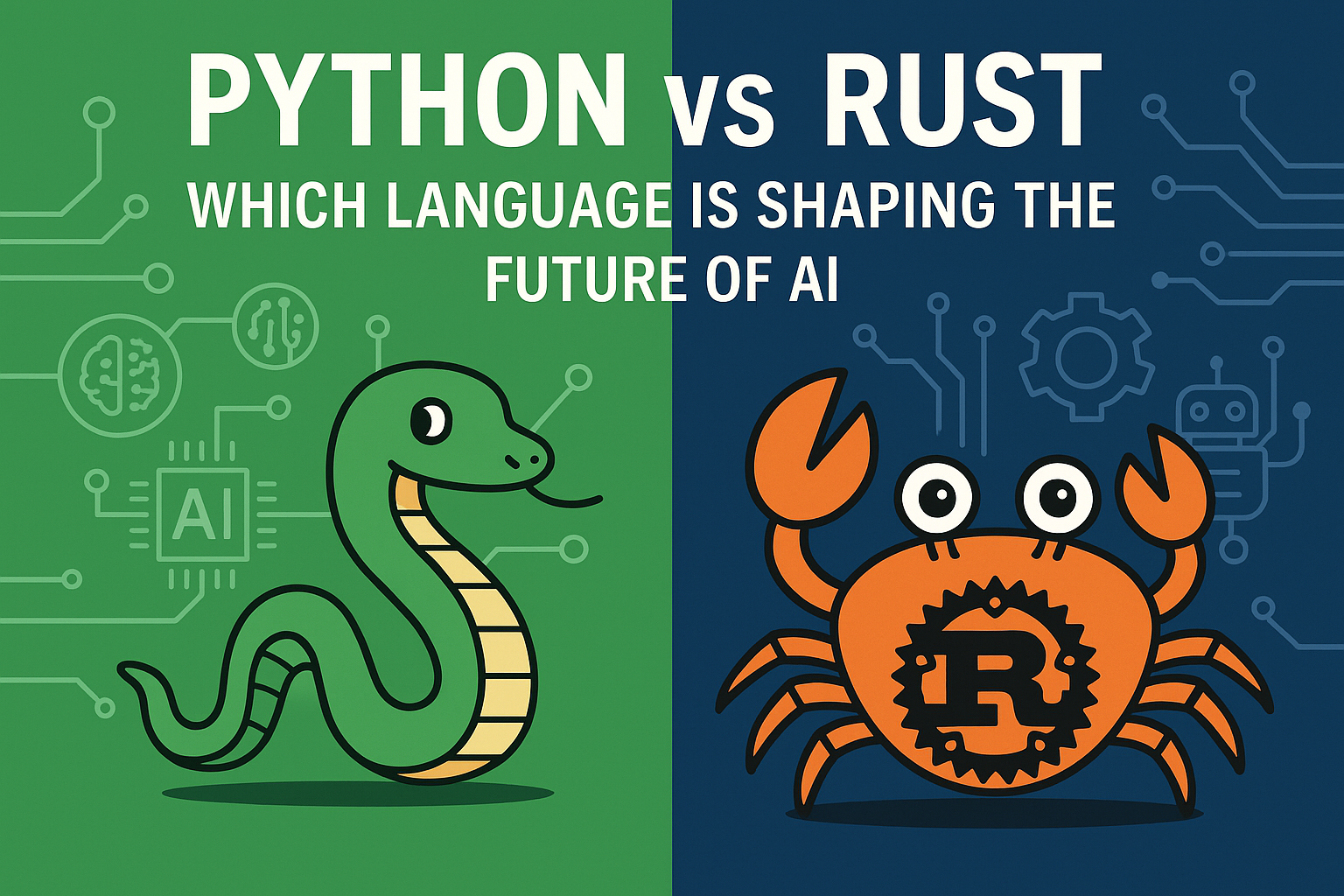
Artificial Intelligence (AI) is transforming every industry, from healthcare and finance to robotics and creative arts. But when it comes to building and scaling these smart systems, one question keeps coming up: Which programming language should you choose?
While Python has long been the king of AI development, Rust is quickly gaining ground for its performance and reliability. In this post, we compare Python vs Rust to see which language is best positioned to shape the future of AI.
Python: The Uncontested Leader in AI (So Far)
Pros:
- Massive ecosystem: Libraries like TensorFlow, PyTorch, scikit-learn, and NumPy dominate AI and data science.
- Easy syntax: Perfect for rapid prototyping and accessible to beginners.
- Huge community: Tons of tutorials, forums, and active contributors.
Cons:
- Slower speed: Python is interpreted, which can be a bottleneck for large-scale or real-time applications.
- Less suitable for production-level, high-performance systems (without relying on C/C++ extensions).
Why is Python still so popular?
It’s simple: Python makes experimenting with complex AI models easy. Most cutting-edge research, academic courses, and data science workflows start with Python.
Rust: The New Challenger for AI Systems
Pros:
- Blazing fast and memory safe: Rust is compiled and eliminates many classes of bugs (no “segmentation faults”).
- Concurrency: Designed for safe and efficient multi-threaded applications.
- Gaining AI support: New libraries like
burn,tract, and Rust bindings for ONNX are making it easier to use Rust for AI and ML.
Cons:
- Smaller ecosystem: Compared to Python, there are fewer AI libraries (but this is rapidly changing).
- Steeper learning curve: Ownership and lifetimes can be tricky for new users.
Where does Rust shine?
Rust is ideal for deploying AI models at scale, especially where speed, reliability, and safety are critical (think: edge devices, robotics, real-time analytics, embedded systems).
Head-to-Head: Python vs Rust for AI
| Feature | Python | Rust |
|---|---|---|
| Speed | Slower (interpreted) | Much faster (compiled) |
| Memory Safety | Relies on GC, can have leaks/bugs | Built-in, prevents most common bugs |
| Ecosystem | Massive, mature, lots of AI/ML tools | Growing, still smaller for AI/ML |
| Ease of Use | Beginner-friendly, simple syntax | Advanced concepts, steeper learning |
| Deployment | Good for research, less for prod systems | Great for scalable, performant apps |
| Community | Huge, active | Smaller but rapidly growing |
Real-World Applications
- Python:
Used in Google’s TensorFlow, OpenAI’s GPT models, academic research, and rapid AI prototyping everywhere. - Rust:
Powering AI in edge computing, robotics (e.g., autonomous drones), and high-speed inference engines.
Which Language Should You Choose for AI in 2025?
- If you’re learning AI or building prototypes:
Start with Python. It’s easier, and the community support is unbeatable. - If you need production-grade, safe, and lightning-fast AI systems:
Consider Rust. It’s the future for embedded AI, high-performance servers, and apps where every millisecond counts.
Pro Tip: Many teams use both—Python for research and prototyping, Rust for optimized deployment!
Frequently Asked Questions (FAQ)
Q1: Can Rust replace Python in AI?
Not completely—yet. Python is still essential for research and experimentation, but Rust is quickly catching up for deployment and performance-critical tasks.
Q2: Are there good AI libraries for Rust?
Yes, and more are appearing every year. Check out burn, tract, tch-rs (PyTorch bindings), and ONNX support.
Q3: Which language is better for AI beginners?
Python. It’s easier to learn and has more learning resources.
Q4: Is Rust used in AI industry projects?
Absolutely! Startups and big companies are using Rust for edge AI, IoT, and scalable inference engines.
Conclusion
The AI landscape in 2025 is more exciting than ever, and both Python and Rust have important roles to play. Whether you’re building the next GPT or optimizing code for a smart device, choosing the right language is key. For most, starting with Python and deploying with Rust may just be the winning combo.
What do you think? Are you Team Python or Team Rust for AI? Share your thoughts in the comments below!

